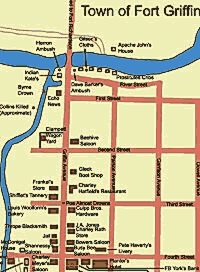Welcome to the captivating story of Fort Griffin, a place where the echoes of the past resonate with tales of conflict and endurance. Situated on the Texas frontier, Fort Griffin was established in 1867, during a turbulent period in American history. This fort was part of a chain of defensive positions designed to protect settlers from the fierce resistance of the Native American tribes who were being steadily pushed off their ancestral lands.
Fort Griffin quickly became a bustling hub of activity and a vital military outpost. Its strategic location made it a key player in the broader narrative of westward expansion. The fort was named after General Charles Griffin, a Union officer renowned for his service during the Civil War. Under his name, the fort became a symbol of the complex and often harsh realities of frontier life.
The soldiers stationed at Fort Griffin faced numerous challenges. The harsh climate, coupled with the ever-present threat of attack, meant that life here was anything but easy. Yet, it was not just the military that defined this place. The fort attracted a diverse group of people, from traders and buffalo hunters to settlers and outlaws. This eclectic mix of individuals created a unique community, albeit a rough and tumble one, known for its saloons and gambling dens.
Among the notable figures associated with Fort Griffin was the infamous outlaw John Wesley Hardin, who was reputed to have killed more than 20 men. His visits to the fort added an air of notoriety, contributing to its legend as a wild and dangerous place.
However, as the frontier moved westward and the threat from Native American tribes diminished, the need for Fort Griffin diminished. By 1881, the military officially abandoned the fort, marking the end of an era. The site gradually fell into disrepair, with its structures slowly succumbing to the elements.
Today, the ruins of Fort Griffin stand as a poignant reminder of the frontier era. They serve as a testament to the resilience and determination of those who lived and worked here, amidst the challenges of an unforgiving landscape. The fort is now part of a state historic site, offering visitors a glimpse into a bygone era and a chance to reflect on the complex history of the American West.
As you explore the remains of Fort Griffin, imagine the bustling life that once filled these grounds. Picture the soldiers in their uniforms, the traders peddling their wares, and the outlaws plotting their next move. Fort Griffin may have had a short life, but its legacy endures, capturing the imagination of all who visit.




